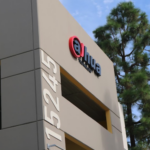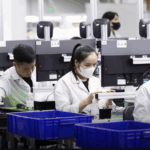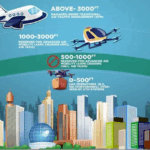AI Revolution in Construction Transforms Site Safety

As the industry continues to evolve, the adoption of advanced technologies undoubtedly plays a crucial role in shaping the future of construction safety and management. Despite technological advancements and increased regulations, safety at construction sites continues to remain a challenge. According to the Bureau of Labor Statistics in the US, in 2021, nearly 1 in 5 workplace deaths occurred in the construction industry. Just over one-third of construction deaths were due to falls, slips, and trips. Of these, almost all were from falls to a lower level. The construction industry accounted for 46.2 percent of all fatal falls, slips, and trips in 2021.
Fortunately, the use of advanced technologies like Artificial Intelligence (AI) and video analytics is revolutionizing safety and security practices. These innovations are not just supplementary tools but pivotal elements in creating safer and more efficient construction environments.
This article explores how these technological advancements are reshaping the roles of safety officers and site managers and enhancing the overall safety culture in construction sites.
Technological advancements in construction safety
The construction industry is witnessing a remarkable transformation driven by technological advancements. These innovations are not just enhancing operational efficiency but are fundamentally reshaping safety measures and protocols on construction sites.
Despite technological advancements and increased regulations, safety at construction sites continues to remain a challenge
Role of video analytics
At the forefront of this technological revolution is video analytics, which leverages sophisticated computer vision algorithms to interpret real-time footage from surveillance cameras. This technology is instrumental in detecting potential hazards, closely monitoring worker activities, and ensuring adherence to safety protocols.
For instance, it can identify when workers are close to high-risk areas or not using necessary safety equipment. Moreover, video analytics serves as an early warning system, automatically alerting stakeholders about abnormal events or potential dangers, thereby preventing accidents and facilitating prompt emergency response. This proactive approach to hazard detection is a significant stride towards mitigating risks on construction sites.
“In the contemporary construction realm, two main technologies which are paving their way towards shaping safety & security are video analytics and generative AI,” said Gary Ng, CEO of viAct. “Video analytics plays a pivotal role by leveraging computer vision algorithms to analyze real-time footage from surveillance cameras. This enables construction sites to detect potential hazards, monitor worker activities, and identify safety compliance issues. Moreover, video analytics can automatically alert stakeholders to abnormal events, helping to prevent accidents and streamline emergency response.”
Transforming construction site safety with Generative AI
Complementing video analytics is AI, which has ushered in a new era of safety planning and risk assessment in construction. Generative AI, a field that has seen remarkable growth in recent years, is at the forefront of this transformation. It possesses the remarkable capability to simulate realistic safety scenarios within construction sites.
It can simulate realistic safety scenarios on construction sites, predicting and mitigating potential risks and hazards. This technology enhances safety awareness among workers through immersive training experiences, equipping them with the skills to identify and respond effectively to dangers. As these innovations gain traction, the construction industry is set to achieve a new level of safety, ensuring both worker well-being and project success.
Utilizing large language models (LLMs), generative AI can simulate a variety of construction scenarios based on historical data, project specifics, and environmental conditions.
This predictive capability is invaluable in identifying potential safety risks and developing preemptive safety measures. Moreover, by creating virtual construction environments, professionals can experiment with different safety protocols and optimize site layouts for maximum efficiency and safety. This data-driven approach empowers stakeholders to make informed decisions, ultimately fostering safer working conditions in the ever-evolving construction landscape.
“Generative AI has revolutionized safety planning and risk assessment in construction,” Ng said. “Through large language models (LLM), generative AI can simulate various construction scenarios based on historical data, project specifications, and environmental factors. This allows for the identification of potential safety risks and the development of proactive safety measures. By generating virtual environments, construction professionals can test different safety protocols and optimize construction site layouts for maximum safety.”
These scenarios extend beyond mere simulations; they have the potential to predict potential risks and hazards, ultimately enhancing safety awareness among the workforce.
Imagine a construction site where generative AI can create lifelike scenarios, complete with potential risks. Workers can undergo safety training with a hands-on, immersive experience, preparing them to identify and respond to dangers effectively. Such advancements promise to elevate safety measures to an entirely new level.
Together, video analytics and generative AI contribute to a data-driven approach to safety and security in construction. These technologies empower stakeholders to make informed decisions, enhance situational awareness, and ultimately create safer working environments in the dynamic and often challenging construction industry.
The construction industry accounted for 46.2 percent of all fatal falls, slips, and trips in 2021
Enhancing communication with large language models
Large Language Models (LLMs) are revolutionizing the way data is processed and communicated in the construction industry. LLMs, with their unparalleled ability to interpret and process vast amounts of textual information, are bridging the communication gap between stakeholders.
“The integration of generative AI with video analytics and large language models (LLMs) holds immense potential for advancing construction site safety,” said Ng. “Future developments may include AI models generating realistic safety scenarios, predicting potential risks, and offering dynamic safety recommendations. LLMs could enhance communication between stakeholders by interpreting and processing vast amounts of textual information, enabling more effective decision-making and proactive risk mitigation in construction environments.”
In construction environments, where effective decision-making and proactive risk mitigation are paramount, LLMs prove invaluable. These models can analyze textual data, providing actionable insights that facilitate improved safety protocols. By interpreting a multitude of data sources and transforming them into actionable recommendations, LLMs empower decision-makers to make informed choices swiftly.
Impact of AI on construction site management
The integration of Artificial Intelligence (AI) in construction site management is revolutionizing the industry’s approach to project execution and risk management. AI algorithms are enabling predictive analytics, allowing project managers to anticipate potential delays or problems before they occur.
This predictive capability is crucial in optimizing resource allocation, scheduling, and budget management, leading to more efficient project timelines and reduced costs.
Changing roles of safety officers
The integration of AI into construction sites has significantly altered the role and responsibilities of safety officers. With routine monitoring tasks now automated through video analytics, safety officers can redirect their focus to more strategic roles. This includes analyzing complex safety data, formulating targeted safety policies, and conducting comprehensive risk assessments. This shift not only enhances the safety protocols but also elevates the officers’ role from supervisors to strategic safety analysts, thereby enriching the overall safety culture within the construction sector.
“The integration of AI in construction sites has a profound impact on the role and responsibilities of safety officers and site managers,” Ng pointed out. “Video analytics and generative AI solution designed for construction safety, automate and augment various aspects of safety management. Safety officers can leverage these technologies to continuously monitor construction sites through video analytics, enabling real-time hazard detection and incident prevention.”
The integration of Artificial Intelligence (AI) in construction site management is revolutionizing the industry’s approach to project execution and risk management
Benefits for site managers
For site managers, the impact of AI is equally transformative. Enhanced situational awareness, enabled by AI, allows managers to make data-driven decisions, optimizing workflows for increased efficiency and safety.
Ng pointed out that a notable example is the implementation of the Project Control Center (PCC) with viAct’s AI by a major property developer in Asia. This integration led to a drastic reduction in non-productive hours per worker, from three hours to just 30 minutes. Such improvements not only streamline operational efficiency but also significantly elevate the safety standards on construction sites.
“With AI taking on routine monitoring tasks, safety officers can shift their focus to more strategic responsibilities such as analyzing complex safety data, formulating targeted safety policies, and conducting in-depth risk assessments,” Ng added. “Site managers benefit from enhanced situational awareness provided by AI, allowing them to make data-driven decisions and optimize workflows for increased efficiency and safety.”
Challenges and industry-wide adaptations
The construction sector, a cornerstone of urban development and economic growth, is itself undergoing a significant transformation. At the heart of this change lies Artificial Intelligence and video analytics. Far from being just a supplementary aid, AI is redefining safety protocols and efficiency standards, tackling the inherent complexities of the industry with unprecedented sophistication.
As construction environments continue to be characterized by their dynamic and ever-changing nature, the integration of AI has become more than advantageous—it’s increasingly indispensable. These intelligent systems, growing in capability and intricacy, are not simply enhancing age-old methodologies – they are essential partners in managing the multifaceted challenges that come with large-scale building projects.
From predictive analytics to real-time risk assessment, AI’s role in driving innovation and ensuring the well-being of workers is proving to be a pivotal turning point for the industry.
Tailoring AI to construction’s needs
Construction sites are inherently ever-changing, presenting a unique set of challenges for any technological solution. AI in construction must contend with shifting layouts, varying personnel, and the introduction of different materials and machinery almost daily. These factors demand AI solutions that are not only robust but also supremely adaptable to maintain safety and efficiency.
The need for adaptable AI algorithms is paramount. These systems must learn and evolve in real time, adjusting to new hazards and environmental changes with minimal human oversight. This level of sophistication is crucial to ensure that AI tools accurately recognize and respond to dynamic site conditions.
“Implementing AI-driven security systems in dynamic construction environments faces challenges due to the ever-changing nature of construction sites,” said Ng. “Obstacles include adapting algorithms to evolving environments, potential false positives/negatives, and addressing the complex interplay of workers and machinery.”
These technologies empower stakeholders to make informed decisions, enhance situational awareness, and ultimately create safer working environments in the dynamic and often challenging construction industry
The accuracy imperative
In the high-stakes environment of construction, the accuracy of AI systems is non-negotiable. Errors in detection — either false positives or negatives — can lead to serious safety breaches or unnecessary work disruptions. Striking the right balance between sensitivity and precision is a key focus for developers in this field.
Upholding data privacy
With AI systems processing vast volumes of data, including sensitive information, the construction industry faces the significant challenge of ensuring data privacy and security. It’s imperative to leverage the benefits of AI while robustly protecting against data breaches and misuse.
“Ensuring data privacy is crucial,” said Gary Ng, CEO of viAct. “Ready-to-use highly trained AI modules can solve by facilitating seamless adoption in dynamic construction environments.”
Varied applications for different project types
AI’s application in construction varies markedly between project types. In residential construction, AI might focus on monitoring specific entry points or detecting hazards in confined spaces. Here, the challenge is to manage smaller spaces and less personnel efficiently.
For commercial construction projects, the challenges scale up. These larger sites, often bustling with activity and featuring multiple access points, demand AI solutions capable of managing crowd safety, overseeing high-traffic areas, and ensuring adherence to complex safety protocols.
“AI systems demonstrate adaptability to diverse safety and security needs by tailoring their approaches to the unique characteristics of construction projects, be it residential or commercial,” Ng said. “For residential buildings, where worker density may be lower, and site layouts differ, AI algorithms can be configured to prioritize real-time monitoring of entry points and potential hazards within confined spaces. In contrast, for commercial buildings with larger footprints and multiple access points, AI systems can be fine-tuned to focus on crowd management, high-traffic areas, and compliance with specific safety protocols relevant to commercial construction.”
The role of machine learning
Machine learning is at the core of AI’s effectiveness in construction. These systems are fed with vast datasets, enabling them to improve and refine their response capabilities continuously. This ability to learn and adapt is what makes AI not just a tool but a versatile ally in construction safety.
“By leveraging machine learning and customization capabilities, AI systems can intelligently adapt their monitoring and analysis strategies to align with the distinct safety challenges and priorities inherent in various construction projects,” Ng added.
The rise of pre-trained AI solutions
The construction industry is witnessing a shift towards pre-trained AI modules. These systems come with foundational learning and can be rapidly deployed in new environments. This approach drastically cuts down the time and resources required for setup, making AI more accessible across various construction projects.
Edge computing: a game changer
Edge computing is revolutionizing AI in construction. By processing data directly at the site, it minimizes latency, enabling real-time data analysis and swift decision-making. This technology is essential for immediate hazard detection and operational efficiency.
Ensuring data security and privacy
In response to growing data security concerns, the industry is adopting stringent measures. Steps like anonymizing data, enforcing strict access controls, and encrypting transmissions are becoming standard. These practices ensure that while AI systems collect essential data for site safety, they also uphold privacy standards and legal compliance.
From predictive analytics to real-time risk assessment, AI’s role in driving innovation and ensuring the well-being of workers is proving to be a pivotal turning point for the industry
The future of AI in construction
Looking ahead, the potential of AI in construction is immense. From advanced predictive analytics to drone-based monitoring and automated machinery, the possibilities are expansive. These advancements promise not only enhanced safety and operational efficiency but also a shift towards more sustainable and cost-effective construction practices.
The industry is at a crossroads where the integration of AI is set to become more profound. This integration, however, is not without its challenges. Maintaining the delicate balance between technological advancement and privacy concerns remains a top priority.
The future of construction will likely see AI becoming an integral part of every phase, from planning to execution. As AI systems become more embedded in construction processes, their impact on safety, efficiency, and overall project management will only grow, heralding a new era of smart construction.
Integration of AI, analytics, and LLMs
As industry leaders envision the future of construction safety, a common thread emerges: the seamless integration of generative AI, advanced video analytics, and LLMs. This convergence of technologies is set to redefine the landscape of construction safety and bring about significant changes in it. These technologies hold the potential to create a safer future by introducing lifelike safety scenarios, predictive capabilities, and improved communication within construction practices
The vision entails a future where generative AI creates realistic safety scenarios, enabling predictive capabilities that revolutionize safety training. LLMs will serve as the bridge that connects stakeholders, offering real-time insights and fostering effective communication. In this envisioned future, innovation aligns seamlessly with safety, setting new standards and propelling the construction industry into an era of heightened security and efficiency.
“We envision the future of construction safety, the seamless integration of generative AI and cutting-edge video analytics, combined with the power of large language models, will redefine the landscape, fostering an environment where innovation aligns with safety, setting new standards for the industry,” added Gary Ng, CEO of viAct.
Ongoing developments underscore the construction industry’s commitment to excellence, emphasizing safety as a top priority in all projects
Conclusion
The construction industry’s dedication to progress and safety is driving innovation in the field. This industry is currently witnessing a significant transformation in safety and security practices. Key among these changes is the integration of generative Artificial Intelligence (AI), video analytics, and Large Language Models (LLMs). These technologies are revolutionizing the conventional approach to safety within construction sites, with the potential to raise industry standards.
These ongoing developments underscore the construction industry’s commitment to excellence, emphasizing safety as a top priority in all projects. This commitment ensures the continued well-being of workers and the sustained success of the sector as it embraces these transformative advancements.




















